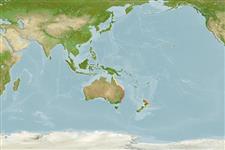Teleostei (teleosts) >
Perciformes/Serranoidei (Groupers) >
Anthiadidae (Fairy basslets or Streamer basses)
Etymology: Hypoplectrodes: Greek, hypo = under + Greek, plektron = sting, spur + Greek, oides = similar (Ref. 45335).
Eponymy: Allan Riverstone McCulloch (1885–1925) was a noted Australian ichthyologist. [...] (Ref. 128868), visit book page.
More on author: Whitley.
Environment: milieu / climate zone / depth range / distribution range
Ecology
Marine; brackish; reef-associated; depth range 1 - 50 m (Ref. 9002). Subtropical
Western Pacific: endemic to Australia.
Size / Weight / Age
Maturity: Lm ? range ? - ? cm
Max length : 45.0 cm TL male/unsexed; (Ref. 33839)
Inhabits shallow coastal and estuarine rocky reefs (Ref. 9002). Common in sponge areas, sometimes in loose aggregations (Ref. 9002).
Life cycle and mating behavior
Maturity | Reproduction | Spawning | Eggs | Fecundity | Larvae
Also Ref. 103751.
Paxton, J.R., D.F. Hoese, G.R. Allen and J.E. Hanley, 1989. Pisces. Petromyzontidae to Carangidae. Zoological Catalogue of Australia, Vol. 7. Australian Government Publishing Service, Canberra, 665 p. (Ref. 7300)
IUCN Red List Status (Ref. 130435: Version 2024-1)
Threat to humans
Harmless
Human uses
Tools
Special reports
Download XML
Internet sources
Estimates based on models
Preferred temperature (Ref.
123201): 17.3 - 24.7, mean 21.8 °C (based on 52 cells).
Phylogenetic diversity index (Ref.
82804): PD
50 = 0.5039 [Uniqueness, from 0.5 = low to 2.0 = high].
Bayesian length-weight: a=0.01349 (0.00618 - 0.02945), b=3.00 (2.81 - 3.19), in cm total length, based on LWR estimates for this (Sub)family-body shape (Ref.
93245).
Trophic level (Ref.
69278): 3.6 ±0.50 se; based on food items.
Resilience (Ref.
120179): Medium, minimum population doubling time 1.4 - 4.4 years (Preliminary K or Fecundity.).
Fishing Vulnerability (Ref.
59153): Low to moderate vulnerability (35 of 100).
Nutrients (Ref.
124155): Calcium = 23.2 [11.3, 59.7] mg/100g; Iron = 0.502 [0.251, 0.895] mg/100g; Protein = 19.4 [17.6, 21.1] %; Omega3 = 0.235 [0.136, 0.403] g/100g; Selenium = 14.4 [6.9, 28.7] μg/100g; VitaminA = 53.6 [15.5, 202.7] μg/100g; Zinc = 0.878 [0.565, 1.348] mg/100g (wet weight);
